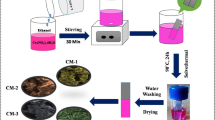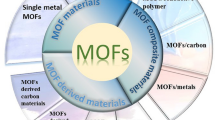Abstract
In the present work, synthesis of CoMn2O4 electrode material through a newly adopted hydrothermal method was achieved and reported. The synthesized material was subjected to various physico-chemical properties to analyze the suitability of the material for the super capacitor applications. The structure of the title compound was confirmed by powder X-ray diffraction studies. Fourier transform infrared spectroscopy confirms the various functional groups associated with the material. Optical and surface analysis was studied by using UV–Visible spectroscopy and field emission scanning electron microscopy. The electrochemical properties of modified electrode CoMn2O4 were investigated using cyclic voltammetry, galvanostatic charge–discharge, cycle stability and electrochemical impedance spectroscopy in electrochemical workstation. Based on the electrochemical properties, the electrode material reveals the ideal capacitance behaviour with high capacitance of 700 F/g at the sweep rate of 5 mV/s in 3 M KCL aqueous electrolyte solution. The remarkable electrochemical performance undoubtedly makes CoMn2O4 as the promising material for supercapacitor applications.









Similar content being viewed by others
References
S. Ponarulselvam, C. Panneerselvam, K. Murugan, N. Aarthi, K. Kalimuthu, S. Thankgamani, Synthesis of silver nanoparticles using leaves of Catharanthus roseus Linn. G. Don and their antiplasmodial activities. Asian Pac. J. Trop. Biomed. 2, 574 (2012)
M. Valden, X. Lai, D.W. Goodman, Onset of catalytic activity of gold clusters on titania with the appearance of nonmetallic properties. Science 281, 1647 (1998)
C.A. Mirkin, R.L. Letsinger, R.C. Mucic, J.J. Storhoff, A DNA-based method for rationally assembling nanoparticles into macroscopic materials. Nature 382, 607 (1996)
Y. Sun, Y. Xia, Shape-controlled synthesis of gold and silver nanoparticles. Science 5601, 2176 (2002)
D.H. Gracias, J. Tien, T.L. Breen, C. Hsu, G.M. Whitesides, Forming electrical networks in three dimensions by self-assembly. Science 289, 1170 (2000)
C. Liu, F. Li, L.-P. Ma, H.-M. Cheng, Advanced materials for energy storage. Adv. Mater. 22, E28 (2010)
S. Chen, J. Zhu, X. Wu, Q. Han, X. Wang, Graphene oxide-MnO2 nanocomposites for supercapacitors. ACS Nano 4, 2822 (2010)
G.-R. Li, Z.-P. Feng, Y.-N. Ou, D. Wu, R. Fu, Y.-X. Tong, Mesoporous MnO2/carbon aerogel composites as promising electrode materials for high-performance supercapacitors. Langmuir 26, 2209 (2010)
P. Ragupathy, H.N. Vasan, N. Munichandraiah, Synthesis and characterization of nano-MnO2 for electrochemical supercapacitor studies. J. Electrochem. Soc. 155, 34 (2008)
L.L. Zhang, X. Zhao, M.D. Stoller, Y. Zhu, H. Ji, S. Murali, Y. Wu, S. Perales, B. Clevenger, R.S. Ruoff, Highly conductive and porous activated reduced graphene oxide films for high-power supercapacitors. Nano Lett. 12, 1806 (2012)
C.D. Lokhande, D.P. Dubal, O.-S. Joo, Metal oxide thin film based Supercapacitors. Curr. Appl. Phys. 11, 255 (2011)
H. Kim, B.N. Popov, Synthesis and characterization of MnO2-based mixed oxides as supercapacitors. J. Electrochem. Soc. 150, D56 (2003)
P. Zhang, X. Li, Q. Zhao, S. Liu, Synthesis and optical property of one dimensional spinel ZnMn2O4 nanorods. Nanoscale Res. Lett. 6, 323 (2011)
X. Zhai, W. Yang, M. Li, G. Lv, J. Liu, X. Zhang, Noncovalent hybrid of CoMn2O4 spinel nanocrystals and poly (diallyldimethylammonium chloride) functionalized carbon nanotubes as efficient electrocatalysts for oxygen reduction reaction. Carbon 65, 277 (2013)
S.A. Hosseini, D. Salari, A. Niaei, F. Deganello, G. Pantaleo, P. Hojati, Chemical-physical properties of spinel CoMn2O4 nano-powders and catalytic activity in the 2-propanol and toluene combustion: effect of the preparation method. J. Environ. Sci. Health A 46, 291 (2011)
J. Habjanic, M. Juric, J. Popovic, K. Molcanov, D. Pajic, A 3D oxalate-based network as a precursor for the CoMn2O4 spinel: synthesis and structural and magnetic studies. Inorg. Chem. 53, 9633–9643 (2014)
E. Jokar, A.I. Zad, S. Shahrokhian, Synthesis and characterization of NiCo2O4 nanorods for preparation of supercapacitor electrodes. J. Solid State Electrochem. 19, 269 (2015)
G. Zhang, X.W.D. Lou, Controlled growth of NiCo2O4 nanorods and ultrathin nanosheets on carbon nanofibers for high-performance supercapacitors. Sci. Rep. 3, 1470 (2013)
R. Wang, Q. Li, L. Cheng, H. Li, B. Wang, X.S. Zhao, P. Guo, Electrochemical properties of manganese ferrite-based supercapacitors in aqueous electrolyte: the effect of ionic radius. Colloids. Surf. A: Physicochem. Eng. Asp. 457, 94 (2014)
J. Li, S. Xiong, X. Li, Y. Qian, A facile route to synthesize multiporous MnCo2O4 and CoMn2O4 spinel quasi-hollow spheres with improved lithium storage properties. Nanoscale 5, 2045 (2013)
L. Hu, H. Zhong, X. Zheng, Y. Huang, P. Zhang, Q. Chen, CoMn2O4 spinel hierarchical microspheres assembled with porous nanosheets as stable anodes for lithium-ion batteries. Sci. Rep. 2, 986 (2012)
Y. Xu, X. Wang, C. An, Y. Wang, L. Jiao, H. Yuan, Facile synthesis route of porous MnCo2O4 and CoMn2O4 nanowires and their excellent electrochemical properties in Supercapacitors. J. Mater. Chem. A 2, 16480 (2014)
A.K. Mondal, D. Su, S. Chen, A. Ung, H.-S. Kim, G. Wang, Mesoporous MnCo2O4 with a flake-like structure as advanced electrode materials for lithium-ion batteries and supercapacitors. Chem. Eur. J. 20, 1 (2014)
N.J. Tharayil, R. Raveendran, A.V. Vaidyan, Synthesis and characterization of nano sized cobalt-manganese spinel oxide. Ind. J. Pure Appl. Phys. 46, 47 (2008)
B. Senthilkumar, R.K. Selvan, P. Vinothbabu, I. Perelshtein, A. Gedanken, Structural, magnetic, electrical and electrochemical properties of NiFe2O4 synthesized by the molten salt technique. Mater. Chem. Phys. 130, 285 (2011)
P. Mahata, D. Sarma, C. Madhu, A. Sundaresenand, S. Natarajan, CoMn2O4 spinel from a MOF: synthesis, structure and magnetic studies. Dalton Trans. 40, 1952 (2011)
J.-L. Liu, L.-Z. Fan, X. Qu, Low temperature hydrothermal synthesis of nano-sized manganese oxide for supercapacitors. Electrochim. Acta 66, 302 (2012)
Acknowledgments
The author P. Vigneshwaran sincerely thanks to TEQIP-II for the financial support to carry out the project work.
Author information
Authors and Affiliations
Corresponding author
Rights and permissions
About this article
Cite this article
Vigneshwaran, P., Kandiban, M., Senthil Kumar, N. et al. A study on the synthesis and characterization of CoMn2O4 electrode material for supercapacitor applications. J Mater Sci: Mater Electron 27, 4653–4658 (2016). https://doi.org/10.1007/s10854-016-4343-6
Received:
Accepted:
Published:
Issue Date:
DOI: https://doi.org/10.1007/s10854-016-4343-6




